Argentina
About Andrew Cusack
 Writer, web designer, etc.; born in New York; educated in Argentina, Scotland, and South Africa; now based in London.
Writer, web designer, etc.; born in New York; educated in Argentina, Scotland, and South Africa; now based in London. read more
News
Blogs
Reviews & Periodicals
Arts & Design
World
France
Mitteleuropa
Knickerbockers
Argentina
The Levant
Africa
Cape of Good Hope
Netherlands
Scandinavia
Québec
India
Muscovy
Germany
Academica
Avenida de Mayo, Buenos Aires
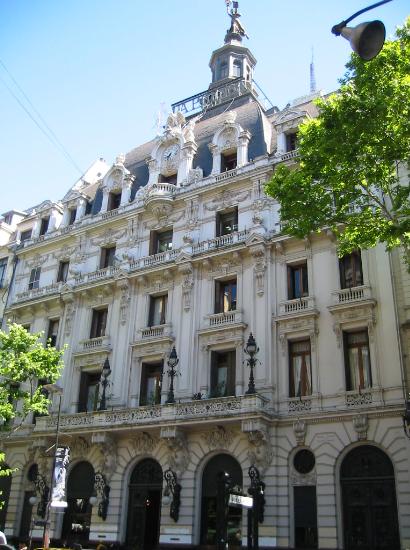
The La Prensa building, formerly home to the newspaper of that name, now the Casa de Cultura.
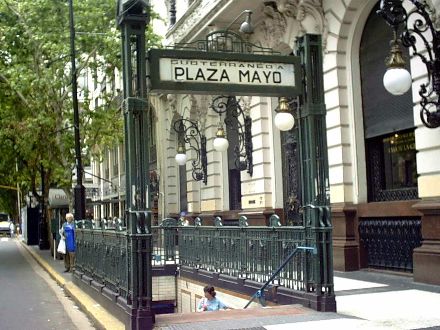
The subte entrance in front of the edificio La Prensa.
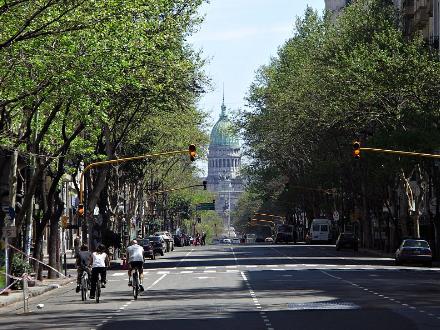
Looking down the Avenida toward the Palacio del Congreso.
The English Tower and Kavanagh Building
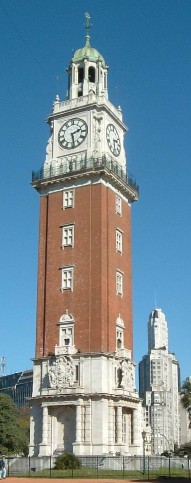 THE SAYING GOES that Argentines are all Italians who speak Spanish and want to be English, which is only just short of the truth. Whatever the quip’s verity, Argentina is a nation of the expatriated and for the centennial year of the 1810 May Revolution, the communities from each of the major mother countries — Spain, Italy, Germany, et cetera — built monuments in dedicated places both to commemorate the contributions their kinsman made to their adopted country as well as to celebrate peace and friendship between Argentina and the given motherland. The Plaza Italia, for example, lamentably bears a monument to the scoundrel Garibaldi, donated by the Italian community.
THE SAYING GOES that Argentines are all Italians who speak Spanish and want to be English, which is only just short of the truth. Whatever the quip’s verity, Argentina is a nation of the expatriated and for the centennial year of the 1810 May Revolution, the communities from each of the major mother countries — Spain, Italy, Germany, et cetera — built monuments in dedicated places both to commemorate the contributions their kinsman made to their adopted country as well as to celebrate peace and friendship between Argentina and the given motherland. The Plaza Italia, for example, lamentably bears a monument to the scoundrel Garibaldi, donated by the Italian community.
For their monumental contribution to the city of Buenos Aires, the English built a tower in the Edwardian style, rather cleverly as it was still the Edwardian period, and the depth of their cleverness was furthered by their naming it the English Tower (officially Torre de los Ingleses, or Tower of the English). Situated in the center of the Plaza Britannia (Britannia Square) at the junction of the San Martin and Libertador avenues, the Tower was designed by engineer Ambrose Poynter and built by Hopkins and Gardom completely (except for mortar) out of materials from England. Around the base are sculptural representations of the English rose, the Scottish thistle, the Welsh dragon, and the Irish shamrock. The dedication at the entrance to the Tower reads “Al Gran Pueblo Argentino. Los residentes británicos. Salud. 25 de mayo 1810-1910” or: “To the Great Argentine People, from the British residents: Salud. May 25, 1810-1910″. Towards the rear of the photo to the right you can see the Kavanagh building (Edificio Kavanagh).
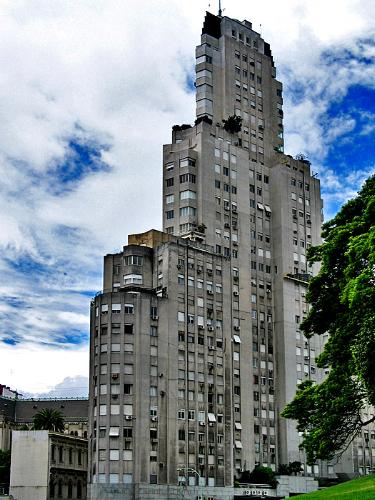
The Kavanagh building is situated on the Plaza San Martin across the avenue from the Plaza Britannia. This 29-storey apartment building was designed by the firm of Sanchez, Lagos, and de la Torre, and was the tallest building in Latin America when built in 1936. The sharp art deco design on an angulated plot is said to resemble a ship at sea, and of course Buenos Aires is a port city — its residents are called porteños after all.
The Kavanagh is unquestionably my favorite ‘modern’ building in Buenos Aires, but then modern architecture has not been kind to the city, at least not in the post-war period (c.f. the National Library). The structures built in the 1950’s were only drab and dull whereas the 60’s and 70’s bore the ill fruits of the ‘lets see how many things we can do with concrete’ trend and tended towards the insidiously hideous rather than the mundane. But no matter however irritating these later obtrusions are, at least Buenos Aires still has the Kavanagh.
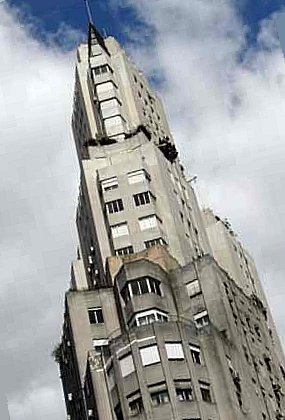
Despite the generations of immigration, investment, interbreeding, and cultural interchange, relations between Argentina and Great Britain were somewhat marred, shall we say, by the shameful attempt by the unhinged wing of the Argentine military to annex the Falklands and rename every geographical feature therein (seriously, I’ve seen the maps). When they were done renaming everything in the Falklands (or ‘Malvinas’ as they would have us believe) the craze apparently spread homewards to the capital. The Plaza Britannia was renamed the Plaza Fuerza Aerea Argentina (from Britannia Square to Argentine Air Force Square), while the Torre de los Ingleses was rechristneed the more ambiguous Torre Monumental. In an even more unfriendly move, the Memorial to the Fallen of the ‘Malvinas’ was built in Plaza San Martin facing the English Tower across the street. In the spirit of peace and friendship, especially regarding two countries which have such deep links as Britain and Argentina, the Memorial really ought to be removed and placed in some other suitable location in the city. Until that time, it remains the Plaza Britannia in my books, and as for the ‘Malvinas’, no such place exists.
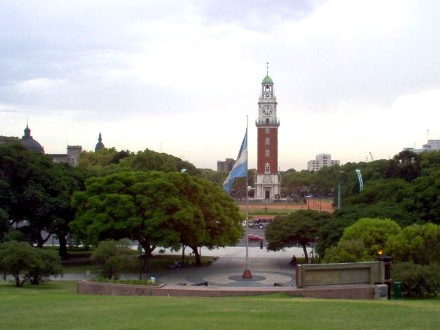
The ‘Malvinas’ memorial viewed from the rear, with the English Tower across the Avenue.
Polo
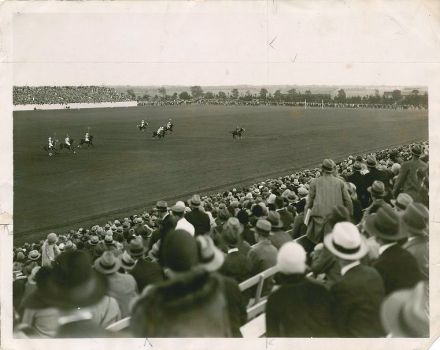
Second international polo match between the United States and the Argentine Republic, 1928.
Squadron Leader Angus McKinnon McVitie (RAF Rtd), Old Philomathian
Last Christmas, Robert Leggat received 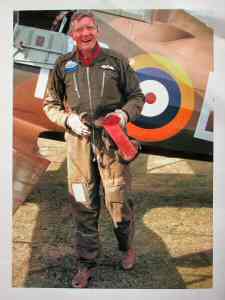 a card that “made [him] sit up with a jolt”. “It was from Angus McVitie, who had been at St. Alban’s a little before my time,” Mr. Leggat recalls, but by pure coincidence was a member of a church he and his wife went to when they arrived in their current home. “He had recognized my OP tie, and from then onwards we met from time to time, and travelled to London to attend an OP reunion. (For the uneducation: and Old Philomathian is a former student of St Alban’s).
a card that “made [him] sit up with a jolt”. “It was from Angus McVitie, who had been at St. Alban’s a little before my time,” Mr. Leggat recalls, but by pure coincidence was a member of a church he and his wife went to when they arrived in their current home. “He had recognized my OP tie, and from then onwards we met from time to time, and travelled to London to attend an OP reunion. (For the uneducation: and Old Philomathian is a former student of St Alban’s).
“His card stated simply that his cancer has spread, and that he expected to be called Home in the next few weeks,” Mr. Leggat writes. “He added that he had ‘the privelege of an interesting and rewarding life and my Christian faith to sustain me.”
As predicted, a few weeks later, Mr. McVitie did die, and his eulogy was read by Jack Wardle, who was his cousin as well as being an Old Philomathian. Here is part of it, reproduced from Mr. Leggat’s website:
Although cousin Angus would loved to have flown, for different reasons, Concorde and the Lancaster, and he had clocked up 11000 flying hours on all sorts of aircrafts, his greatest delight was the award of an Honorary Fellowship of the Society of Experimental Test Pilots in 1994 when he was numbered, amongst others, with Group Capt. John Cunningham of Comet fame, Charles Lindberg, Air Commodore Sir Frank Whittle. He had previously, in 1988, received The Derry and Richards Memorial Medal, from the Guild of Air Pilots and Air Navigators, for test flying of outstanding value.
Although no prizes to guess his Scottish ancestry, it all began in The Forgotten Colony – Argentina. The English, Irish, Welsh and Scots had settled there in the 19th Century, making an incredible contribution without actually ruling the place! They formed their own communities..most of the Scots were farmers as were my ancestors, forming strong matriarchal societies marrying others who came over the horizon!. They celebrated St Andrew’s Day and Burns Night, had Gatherings of the Clans and Caledonian Balls, started their own Scots Church with itinerant ministers, schools and cemeteries. Practically everybody was related, or thought they were, however distant.
Eventually we ended up in St. Alban’s College, a public School. Angus was a Day Boy; I a boarder which meant invites to tea etc. and I well remember his bedroom, littered with The Meccanno Magazine and models of Aeroplanes all over the place as well as hanging from the ceiling. We were also members of a boy’s Bible Class called Crusaders, run by one of the masters, Charlie Cohen, which also meant free tea and plenty of wads!
That’s where it all began. He just wanted to fly and there was no action in Argentina. So in 1943, in mid war, he worked his passage on a banana boat to Britain and joined the Bristol Aeroplane Company at Filton, Bristol as a student apprentice. It was the nearest he could get to aeroplanes, but discovered he could learn to fly Tiger Moths at the University Air Squadron. That’s when we joined up again about 1947/8… Bristol, Filton and Crusader leaders, where he was highly regarded. One of the seniors, now well into his 80’s, remembers him as a “genial, gentle, giant”.
The next stop was Glasgow University, early 50’s perhaps, where we tried to do Aeronautical Engineering. He flew most of the time and we lived in a place called Duntocher, which has disappeared, under motorways and development. The bungalow belonged to a certain Donald McLeod, whc had been commissioned in The Black Watch during the war, and was in ministerial training. The problem was looking after the place and studying at the same time. We often recruited, had to recruit, the ladies from the College of Domestic Science to spend a Saturday with us doing the necessary cleaning and cooking.
By 1950 he had decided on a career in the RAF and gained his ‘wings’ in 1951 at Syerston, Nottinghamshire. Posted to Transport Command, he served in the Middle East, during the Mau Mau Emergency. He was ADC flying top brass about as well as in his own words ‘dropping Bronco’ from Valettas and Ansons. He managed to fit in a wedding to Sheila in 1957.
But all along, his boyhood ambitions was in test flying, as did so many in that era. In 1956 he was accepted for the Empire Test Pilots School at the Royal Aircraft Establishment at Farnborough — “the hardest years’ work I ever did” — and stayed on there for three years after qualifying, as the last test pilot with the National Turbine Establishment.
Then, all set to return to Transport Command Brittania Squadron at Lyneham, someone called him back and asked, rather apologetically, if he wouldn’t mind going instead to RAE Bedford as Commanding Officer of Aero Flight, which was, in those days a plum test pilot’s job. After two years, there was Staff College at Bracknell, followed by secondment to the Royal Malaysian Air Force running their Joint Operations Centre during the emergency. A desk job at the MOD, dealing mostly with fighter and helicopter cockpits was a pain…endless meetings fighting with financiers and so much being cancelled, with hardly any flying, decided him to take early retirement with the rank of Squadron Leader, and joined the College of Aeronautics at Cranfield Aerodrome as Chief Test Pilot in 1968.
But for all that, and its quite a career, Angus’s greatest joy was Sheila and Shuna, Fiona and Lorna… as he wrote in his Christmas card “the privilege of our interesting and rewarding life and my Christian faith to sustain me”. He had already written “my time to be with the Lord is fast approaching”. Well, that is where he is which is far better. He knew from an early age the assurance and certainty that his name was written in the “Lamb’s book of Life” (Rev 21.27).
Eternal rest grant unto him, O Lord, and let perpetual light shine upon him. May he rest in peace. Amen.
Search
Instagram: @andcusack
Click here for my Instagram photos.Most Recent Posts
- Bicycle Rack April 29, 2024
- Burns Tower April 19, 2024
- Patrick in Parliament March 18, 2024
- Articles of Note: 13 March 2024 March 13, 2024
- Cambridge March 9, 2024
Most Recent Comments
Book Wishlist
Monthly Archives
Categories


